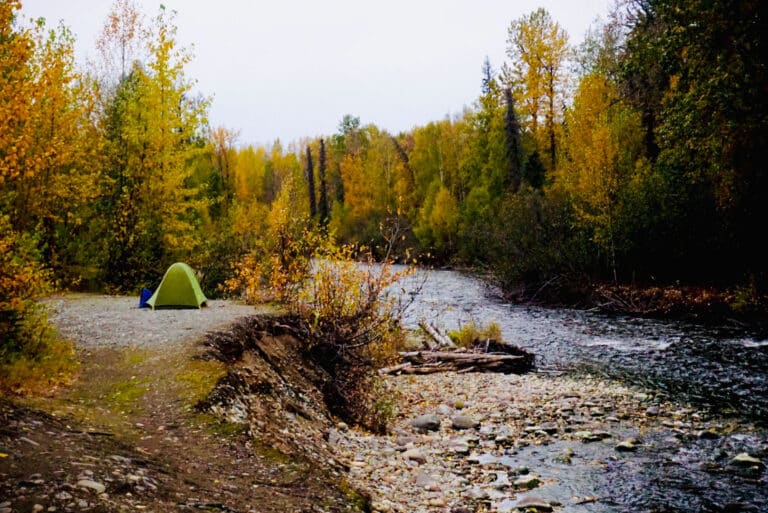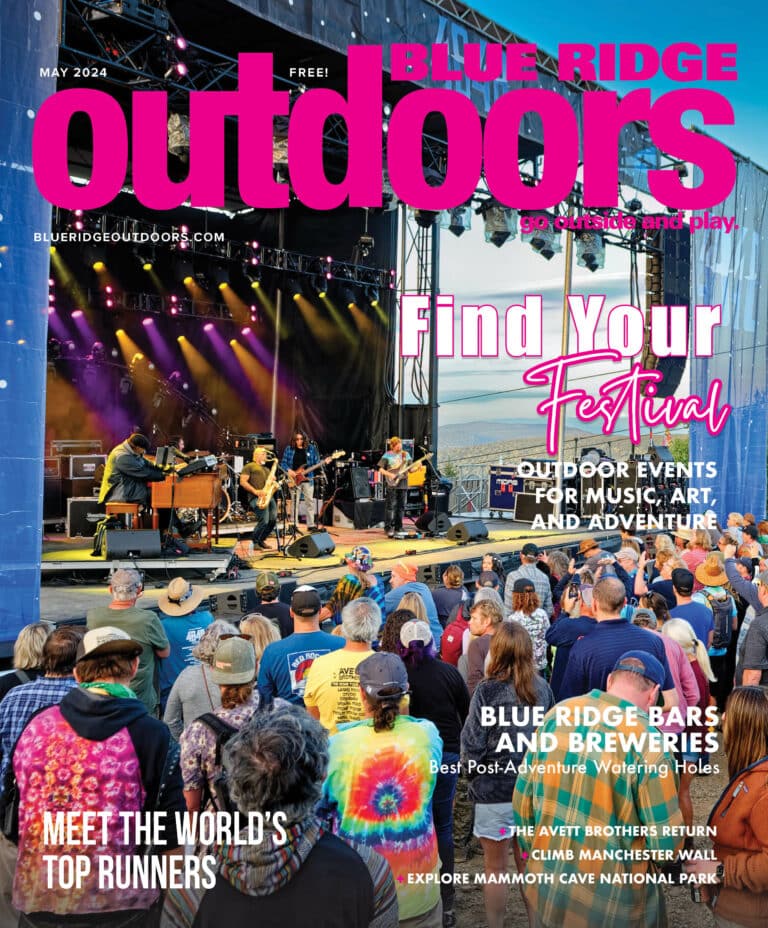When the snow falls in the South, it’s time to get out there. Here’s where to cross-country ski, snowshoe, and climb ice in the Blue Ridge.
Chip Chase, longtime owner of White Grass Ski Touring Center in West Virginia’s Canaan Valley, still gets excited at the first sight of snow. “It changes your favorite places in the world that you have always loved into this magic winter landscape,” Chase says. “Obviously if you’re in the Southeast, it’s not going to last very long. So it’s kind of like here today, gone tomorrow. It makes it pretty special. Snow is something to relish.”
Especially this year, when isolated wild lands have been embraced more than ever as safe havens, there’s never been a better time to bundle up and enjoy every bit of powder that falls in the Blue Ridge backcountry. Winter activities in the South require the right conditions, so when the flurries accumulate, head to the mountains for one of these cold-weather adventures.
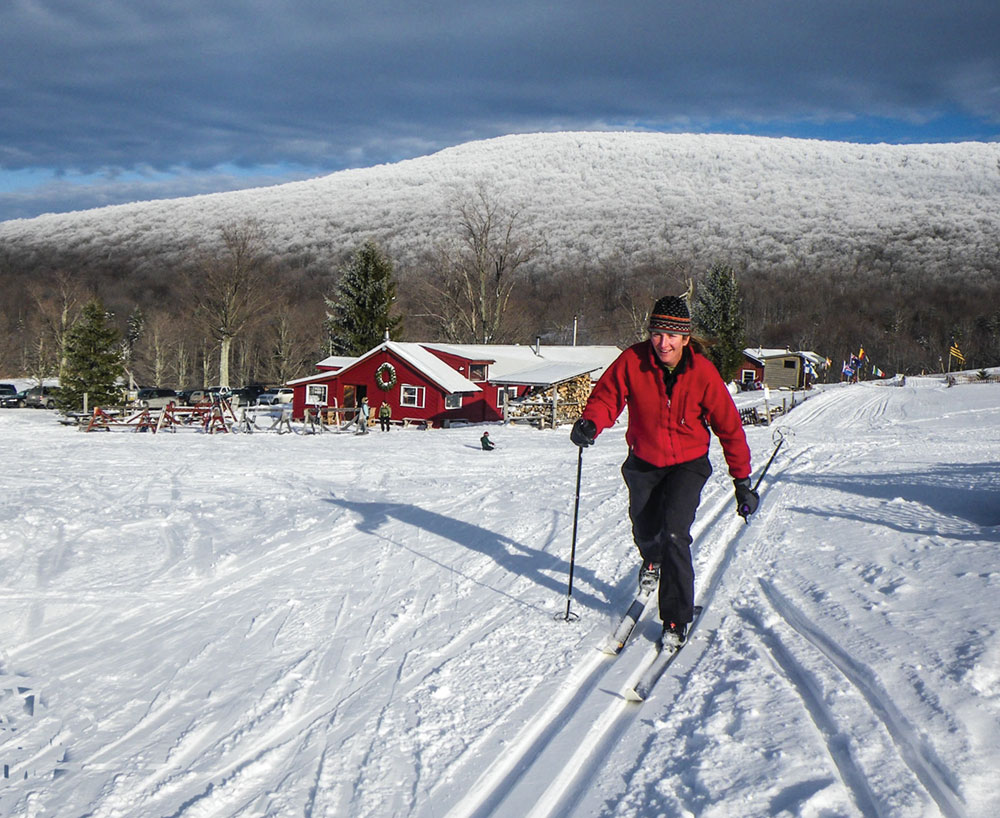
Go Cross-Country in West Virginia
While more popular in areas farther north with more snow, there are some scenic gems in the Blue Ridge region that offer a good introduction to cross-country skiing. White Grass is one of the best— a four-plus decade mainstay that benefits from the Canaan area’s high elevations and cold climate. The center has more than 30 miles of onsite trails, half of which are regularly groomed, and it offers fast access to the majestic terrain in the nearby Dolly Sods Wilderness and the Monongahela National Forest.
The area gets a decent stash of powder for the South, boasting an average of 90 skiable days a year, and at White Grass, they collect natural snow to feed to their trails in order to keep things running throughout the season. “We work really hard to make conditions that are thin still work,” Chase said. “How can we be open with an inch of really good packed snow? How can trails be dry and smooth? Our mode is to try to get people out there as often as we can.”
For beginners, White Grass offers cheap one-hour lessons to nail down the basics, and Chase recommends starting with shorter routes to get a feel for trail conditions. “Bite off less than you can chew,” he said. “If you come back and you’re tired, it’s no fun. You’ve got to know how far you’re going, the terrain, and where you’re going.”
Operations at White Grass will look slightly different this year due to COVID-19, with limited access inside the lodge and all food being carryout. Paying for passes and ordering food will be done via smartphone to limit person-to-person interactions. “I think cross-country skiers are naturally socially distanced,” Chase said. “We’re hoping to have more of a tailgate winter where people change their boots right in the car rather than coming into the lodge to do it.”
More to Explore:
Additional spots in the South that get relatively reliable snow include Virginia’s Grayson Highlands State Park, which features high-elevation open meadows and miles of trails to explore. And similar terrain can be found at Tennessee’s Roan Mountain State Park, which features vast grassy balds that get covered with more than 100 inches of snow annually.
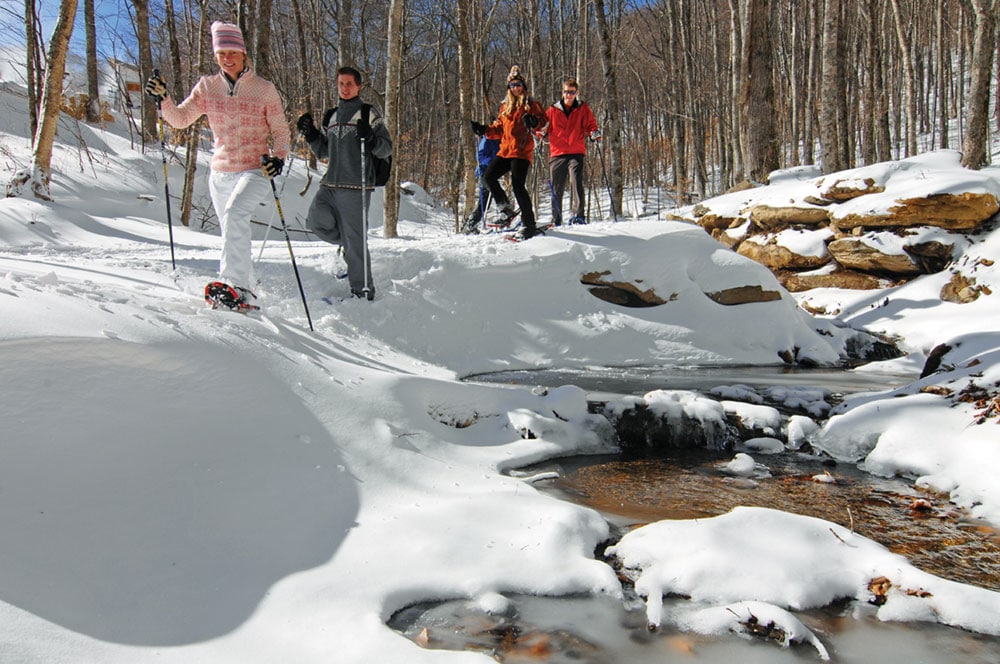
Snowshoe the North Carolina High Country
Set well above 5,000 feet, the North Carolina High Country is another part of the Blue Ridge that gets a fair share of powder. Snowshoeing is a great, low-impact way to cover the craggy area’s bounty of snow-covered trails. But those who’ve never strapped snowshoes over their boots can give it a try at Sugar Mountain Resort, which offers guided tours that include equipment rentals. Located in Banner Elk, the resort—which also has 21 downhill slopes—has guides tailor the snowshoe tour routes to participant abilities.
“It’s great exercise and half the time you don’t even know you’re exercising because often it’s just a beautiful walk in the woods during the winter,” said Kimberley Jochl, Sugar’s vice president, of snowshoeing’s aerobic benefits. “It’s exhilarating.”
On Winter Trails Day (January 3, 2021) Sugar will offer free snowshoe tours all day.
Nearby, Moses Cone Memorial Park, located at mile marker 294 along the Blue Ridge Parkway near Boone, is another great place to get acquainted with walking in snowshoes. The park has 25 miles of gently sloping carriage trails that are perfect for finding a stride but also enjoying some solitude.
“[Snowshoeing is] infinitely easier but has a lot of the same elements that cross-country skiing has,” said Chase, who also hosts a lot of snowshoers at White Grass. ”So you can focus more on what’s around you. You’re out in the quiet and hush of winter.”
More to Explore:
Snowshoeing can be done pretty much anywhere with enough snow, so it’s a great backyard winter activity when you’re staying close to home. But if you’re chasing powder, another stellar spot to explore on snowshoes is Swallow Falls State Park, which has a mild-graded trail system in a scenic part of western Maryland that banks 100 inches of snow a year.
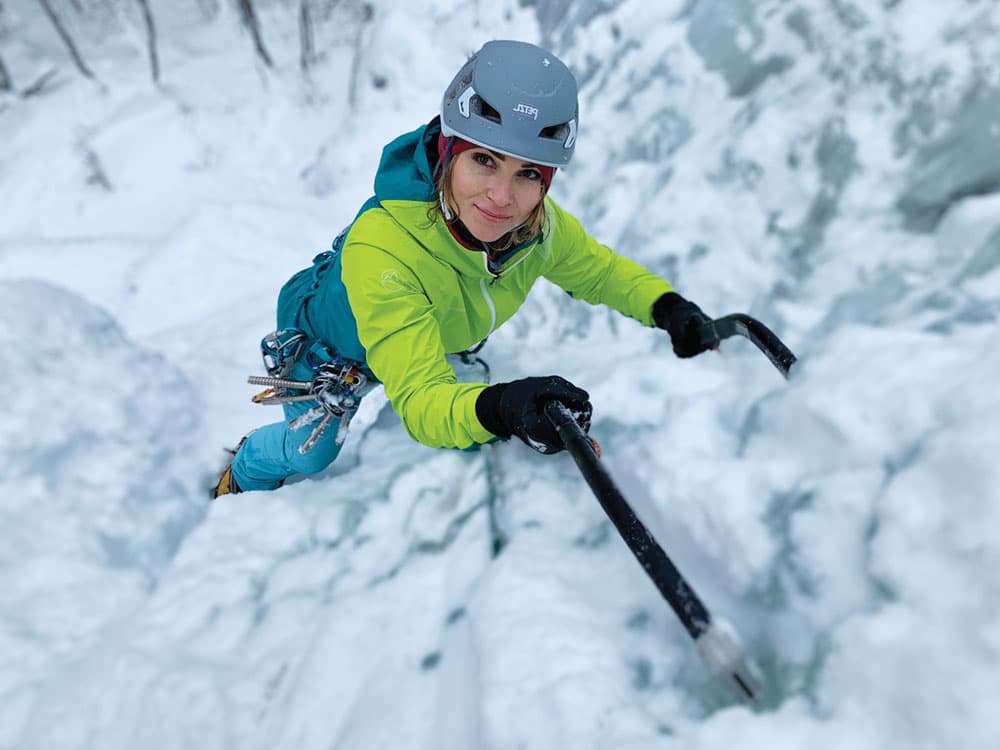
Take a Guided Ice Climbing Trip
Ice climbing can be hit or miss in the South. Ascending a frozen face is more of a rare opportunity than a regular activity in the region, but it is certainly possible to get some use out of a pick and crampons in the Blue Ridge, especially with experienced climbing guides on the lookout for the right conditions.
“Looking at the forecast, it’s still hard to predict how well a particular feature is going to form,” said Cristin Knowlton, owner of Fox Mountain Guides, an outfitter that leads ice climbing trips in North Carolina. “Our guides go out and scout the locations ahead of time to see how well formed it is. Sometimes we’ll have freeze-thaw cycles that can actually be better for ice. If it freezes up, falls out, and then refreezes, that can make for better ice than if it is just a really hard freeze one night. It’s important to lay eyes on the ice and see.”
Spots vary when it comes to finding a frozen slab in Appalachia, but some of North Carolina’s best-known ice routes are found at Linville Falls and Whiteside Mountain. Unlike climbing rock, which is a fixed medium, climbing ice is entirely dependent on the weather, so hiring a guide during prime conditions can make the experience safer and more enjoyable.
“There’s a lot you need to know about ice because there’s a lot of risk involved,” said climbing guide Anthony D’Ercole, who also says to expect a learning curve when both swinging picks and getting used to crampons on your feet. “Any time you swing into a frozen chunk of ice, it’s going to break depending on how it’s delaminated, how it formed, how the snow’s sitting on top of it, the different thermal layers, and the temperature outside.”
Fox Mountain Guides offers ice climbing day trips and multi-day courses that teach fundamentals.
More to Explore:
Up north in Virginia, Blue Ridge Mountain Guides (blueridgemtnguides.com) offers guided trips to the ice crags off the Blue Ridge Parkway, not far from Wintergreen Resort.
……………………………………………………………….
A Different Ski Season
Rudy Ryback was on the slopes the day most resorts in the Southeast decided to shut down in March 2020 due to COVID-19. “It was a very somber day,” he said. “There was a lot of confusion, like should we be doing this, should we not. There were no precautions at that point. You just stayed away from people as much as possible in the lodge. It was kind of an eerie feeling being up there then.”
Ryback, who covers 17 regional ski resorts for SkiSoutheast.com, typically spends 50 to 60 days a season skiing and snowboarding. Heading into this winter, things at the resorts will look a little different from the last time he was on the slopes. “Skiing is such a social sport,” Ryback said. “You meet so many people just on the lift ride up to the top. Well, that’s going to be totally different this year.” Resorts will be spacing lift lines out to maintain social distancing. Most will not require anyone to ride up with someone not in their group, although visitors may have to wait in line longer. Many places, like Seven Springs Mountain Resort, have implemented a no-touch online purchasing system to allow guests to buy season passes, lift tickets, equipment rentals, and lessons ahead of time, while Snowshoe Mountain Resort will tightly regulate the number of daily lift tickets sold.
Ryback said he’s making a few personal changes as well, like packing a lunch and eating in his car to avoid spending time indoors. He also plans to spend more time skiing the backcountry away from the major resorts. “There’s a couple of these first descents off the back of Mt. Mitchell I’m trying to tackle,” Ryback said. “The conditions have to be super right. It’s so steep you kind of have to ice climb up from the bottom in certain places and you can only ski down sections. I really think that’s the way to go this year. I think this could be the year for the true explosion of more backcountry skiing.” He’ll also spend time at Roan Mountain for some alpine touring and cross-country skiing.
As people look for activities they can do outdoors within driving distance, it’s important to remember we are still in the middle of a global pandemic. “Some of the resorts out West and in the Northeast, they’re going to be doing a reservation system just to ski because they have to keep the capacity down,” he said. “But I don’t know of any of the resorts around here doing that. I feel like there needs to be something at the very outset of the season to limit capacity.”
Ryback does see this season as a chance for resorts to reevaluate their procedures. “If there’s any one thing I’d love for the industry down here to look into more is uphill skiing,” he said. “If I can save a spot on the chair for someone else, that’s great. I feel like I’m doing my part more. Only one or two [resorts in the Southeast] allow for this uphill skiing. Otherwise it’s totally banned. But if there was any year, if there was anything that got just a little more interest or involvement, it might be that.” •
Please check local guidelines and regulations before making plans to get outside. Confirm with locations to make sure access is open to the public. Remember to practice social distancing, wear a mask, and respect others’ health when outside.
Cover photo: Ice climbers prepare to ascend a frozen Linville Falls in North Carolina. Photo by Peter Lorenz.

